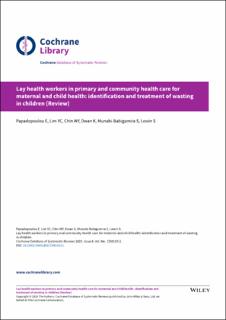| dc.description.abstract | Background
Since the early 2010s, there has been a push to enhance the capacity to effectively treat wasting in children through community‐based service delivery models and thus reduce morbidity and mortality.
Objectives
To assess the effectiveness of identification and treatment of moderate and severe wasting in children aged five years or under by lay health workers working in the community compared with health providers working in health facilities.
Search methods
We searched MEDLINE, CENTRAL, two other databases, and two ongoing trials registers to 24 September 2021. We also screened the reference lists of related systematic reviews and all included studies.
Selection criteria
We included randomised controlled trials (RCTs) and non‐randomised studies in children aged five years or under with moderate wasting (defined as weight‐for‐height Z‐score (WHZ) below −2 but no lower than ≥ −3, or mid‐upper‐arm circumference (MUAC) below 125 mm but no lower than 115 mm, and no nutritional oedema) or severe wasting (WHZ below −3 or MUAC below 115 mm or nutritional oedema).
Eligible interventions were:
• identification by lay health workers (LHWs) of children with wasting (intervention 1);
• identification by LHWs of children with wasting and medical complications needing referral (intervention 2); and
• identification by LHWs of children with wasting without medical complications needing referral (intervention 3).
Eligible comparators were:
• identification and treatment of wasting by health professionals such as nurses or doctors (at health facilities); and
• identification and treatment of wasting by health facility‐based teams, including health professionals and LHWs.
Data collection and analysis
Two review authors independently screened trials, extracted data and assessed risk of bias using the Cochrane risk of bias tool (RoB 2) and Cochrane Effective Practice and Organisation of Care (EPOC) guidelines. We used a random‐effects model to meta‐analyse data, producing risk ratios (RRs) for dichotomous outcomes in trials with individual allocation, adjusted RRs for dichotomous outcomes in trials with cluster allocation (using the generic inverse variance method in Review Manager 5), and mean differences (MDs) for continuous outcomes. We used the GRADE approach to assess the certainty of the evidence.
Main results
We included two RCTs and five non‐RCTs. Six studies were from African countries, and one was from Pakistan. Six studies included children with severe wasting, and one included children with moderate wasting. All studies offered home‐based ready‐to‐use therapeutic food treatment and monitoring. Children received antibiotics in three studies, vitamins or micronutrients in three studies, and deworming treatment in two studies. In three studies, the comparison arm involved LHWs screening children for malnutrition and referring them to health facilities for diagnosis and treatment.
All the non‐randomised studies had a high overall risk of bias.
Interventions 1 and 2
Identification and referral for treatment by LHWs, compared with treatment by health professionals following self‐referral, may result in little or no difference in the percentage of children who recover from moderate or severe wasting (MD 1.00%, 95% confidence interval (CI) −2.53 to 4.53; 1 RCT, 29,475 households; low certainty).
Intervention 3
Compared with treatment by health professionals following identification by LHWs, identification and treatment of severe wasting in children by LHWs:
• may slightly reduce improvement from severe wasting (RR 0.93, 95% CI 0.86 to 0.99; 1 RCT, 789 participants; low certainty);
• may slightly increase non‐response to treatment (RR 1.44, 95% CI 1.04 to 2.01; 1 RCT, 789 participants; low certainty);
• may result in little or no difference in the number of children with WHZ above −2 on discharge (RR 0.94, 95% CI 0.28 to 3.18; 1 RCT, 789 participants; low certainty);
• probably results in little or no difference in the number of children with WHZ between −3 and −2 on discharge (RR 1.09, 95% CI 0.87 to 1.36; 1 RCT, 789 participants; moderate certainty);
• probably results in little or no difference in the number of children with WHZ below −3 (severe wasting) on discharge (RR 1.23, 95% CI 0.75 to 2.04; 1 RCT, 789 participants; moderate certainty);
• probably results in little or no difference in the number of children with MUAC equal to or greater than 115 mm on discharge (RR 0.99, 95% CI 0.93 to 1.06; 1 RCT, 789 participants; moderate certainty);
• results in little or no difference in weight gain per day (mean weight gain 0.50 g/kg/day higher, 95% CI 1.74 lower to 2.74 higher; 1 RCT, 571 participants; high certainty);
• probably has little or no effect on relapse of severe wasting (RR 1.03, 95% CI 0.69 to 1.54; 1 RCT, 649 participants; moderate certainty);
• may have little or no effect on mortality among children with severe wasting (RR 0.46, 95% CI 0.04 to 5.98; 1 RCT, 829 participants; low certainty);
• probably has little or no effect on the transfer of children with severe wasting to inpatient care (RR 3.71, 95% CI 0.36 to 38.23; 1 RCT, 829 participants; moderate certainty); and
• probably has little or no effect on the default of children with severe wasting (RR 1.48, 95% CI 0.65 to 3.40; 1 RCT, 829 participants; moderate certainty).
The evidence was very uncertain for total MUAC gain, MUAC gain per day, total weight gain, treatment coverage, and transfer to another LHW site or health facility.
No studies examined sustained recovery, deterioration to severe wasting, appropriate identification of children with wasting or oedema, appropriate referral of children with moderate or severe wasting, adherence, or adverse effects and other harms.
Authors' conclusions
Identification and treatment of severe wasting in children who do not require inpatient care by LHWs, compared with treatment by health professionals, may lead to similar or slightly poorer outcomes. We found only two RCTs, and the evidence from non‐randomised studies was of very low certainty for all outcomes due to serious risks of bias and imprecision. No studies included children aged under 6 months. Future studies must address these methodological issues. | en_US |

